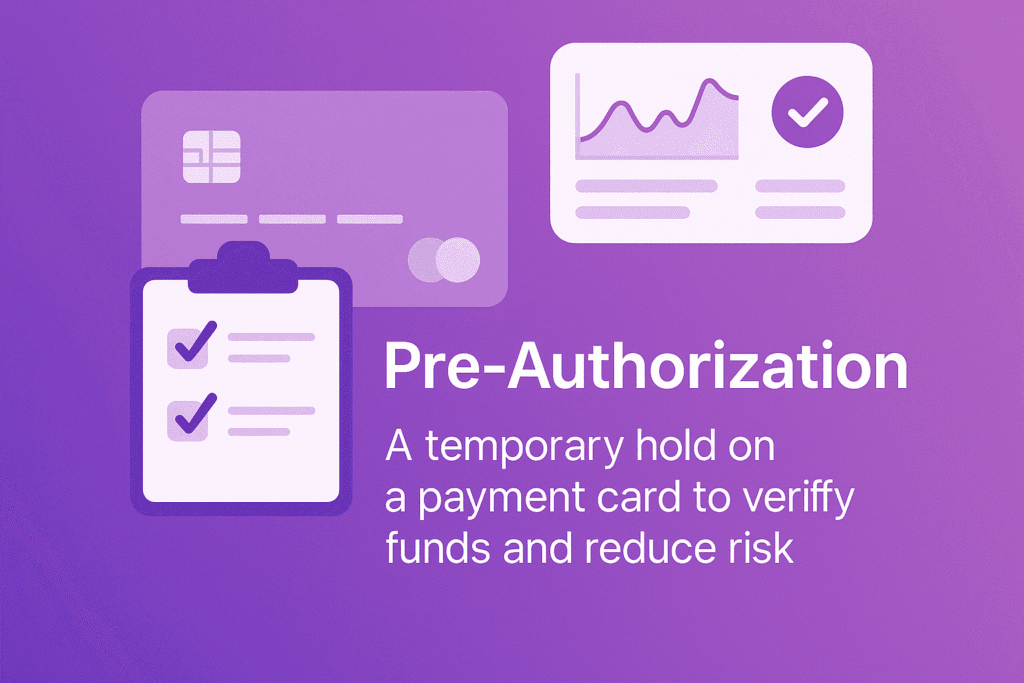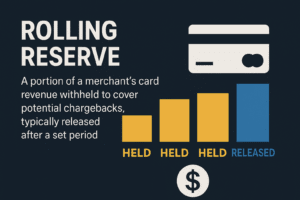What Pre-Authorization Really Means
Pre-authorization is much more than a fraud prevention tool. It is a payment optimization strategy that validates a cardholder’s intent and card status before a charge is finalized. In simple terms, it’s a small hold or zero-amount verification that checks if a payment card is valid, funded, and approved by the issuer.
For subscription and high-risk merchants, this early validation prevents failed renewals, reduces declines, and improves authorization rates. It also adds a critical layer of compliance by showing that the merchant confirms consent before processing any recurring transaction.
According to Visa’s authorization best practices, merchants that actively manage pre-authorization and routing can improve approval rates by up to 15 percent while significantly lowering fraud-related disputes.
Why Pre-Authorization Matters for Growing Businesses
Payment friction, failed renewals, and disputes cost merchants millions each year. Studies show that up to 25 percent of subscription renewals fail because of expired or blocked cards, while friendly fraud now accounts for over half of all chargebacks in recurring models.
Pre-authorization helps prevent these issues before they happen. It allows merchants to:
-
Validate cards before the renewal date
-
Detect expired or risky cards early
-
Reduce “unrecognized charge” disputes
-
Confirm customer intent before billing
-
Improve approval rates and reduce declines
For acquirers and PSPs, consistent pre-authorization behavior signals a proactive, compliant merchant, helping maintain Visa VAMP and VDMP ratios within safe thresholds.
Related Reading:
Pre-authorizations are only one part of the bigger picture. Understanding how other types of authorizations work, including incremental, partial, and reversal flows, can help merchants refine their overall approval strategy. Learn more in our comprehensive article on Types of Transaction Authorizations Explained.
1. Improve Approval Rates and Revenue
Pre-authorization gives visibility into which issuers and BINs deliver the best approval performance. Over time, this data allows routing payments through optimal acquirers, improving approval success by 5–12 percent.
It also minimizes unnecessary retries and hard declines, which can damage a merchant’s standing with acquirers.
2. Lower Decline Ratios and Strengthen Retention
Every failed renewal is potential lost revenue. Running a pre-authorization one to three days before renewal lets you prompt customers to update their card before billing. This simple step can recover up to 20 percent of failed renewals and improve lifetime customer value.
Merchants that use pre-authorization also experience fewer involuntary churn cases and smoother renewal cycles.
3. Greater Cash Flow Predictability
Running pre-authorizations before each billing cycle helps finance teams predict expected revenue accuracy. They can see which transactions are likely to succeed or fail and adjust cash-flow forecasts accordingly.
This predictability is especially valuable in high-risk verticals where settlement cycles are shorter and transaction volumes fluctuate.
4. Compliance and Regulatory Alignment
Visa, Mastercard, and PSD2 guidelines recommend verifying cardholder intent before recurring billing. Pre-authorization supports this by confirming that a customer’s card and consent are valid before initiating payment.
Merchants who adopt this model show a strong compliance posture, reducing the risk of entering Visa’s monitoring programs or facing penalties for high dispute ratios.
For reference, see Chargebacks911.
5. Enhanced Customer Experience
Customers appreciate transparency. A short pre-authorization with a clear descriptor and a notification email helps them recognize upcoming renewals and prevents confusion about unexpected charges.
According to global subscription benchmarks, 70 percent of users prefer services that communicate billing clearly, leading to higher satisfaction and retention.
Pre-authorization builds that trust while keeping the experience frictionless.
6. Fraud and Abuse Prevention
Pre-authorization exposes invalid or stolen cards before real funds are captured. When combined with fraud tools such as 3D Secure, IP monitoring, or device fingerprinting, it adds a front-line barrier against abuse.
This hybrid approach reduces unauthorized activity and ensures that only verified users continue into the billing flow.
7. Better Data for Optimization
Every pre-authorization generates valuable insights – issuer ID, approval code, region, and card type. Over time, this data shapes smart routing, retry logic, and geo-performance mapping.
Merchants that actively use pre-authorization data see 10–15 percent lower transaction costs and higher authorization consistency.
8. Chargeback Reduction and Evidence Strengthening
Although pre-authorization is not only about disputes, it remains one of the most effective ways to reduce them.
A logged pre-authorization serves as timestamped evidence that a customer initiated a transaction voluntarily, supporting dispute defense and representment cases.
Reports shows that merchants using structured pre-authorization flows reduce chargebacks by 20–30 percent within three months.
9. Reduced Operational Costs
Every failed charge or dispute consumes manual time and increases processor fees. By using pre-authorization to detect problems early, merchants save operational hours and reduce support requests related to failed or duplicate charges.
Even avoiding a small percentage of disputes saves significant money. The typical handling cost of a chargeback ranges from 20 to 100 dollars, excluding lost revenue.
10. Industry Applications
| Industry | Primary Use of Pre-Auth | Key Benefit |
|---|---|---|
| Adult Entertainment | Validates consent and card legitimacy | Reduces privacy-related disputes and keeps ratios within Visa thresholds |
| Gaming and Digital Goods | Verifies player and payment intent | Reduces fraud from unauthorized or trial abuse |
| SaaS and Streaming | Validates renewals and trial-to-paid transitions | Improves retention and user trust |
| Travel and Bookings | Uses estimated and incremental authorizations | Matches payment with staged delivery and cancellations |
| E-Commerce and Retail | Reserves funds for high-value orders | Prevents uncollected deliveries and reduces refund exposure |
11. Quantifiable Impact
-
Visa data: Authorization optimization can improve merchant revenue by up to 15 percent.
-
Subscription data: Pre-authorization before renewal reduces failed payments by 10–25 percent.
-
Chargebacks911: Structured pre-authorization workflows reduce chargebacks by 27 percent on average.
-
The Nilson Report: Global card fraud losses exceeded $30 billion in 2023, reinforcing the need for stronger pre-validation layers.
What to consider
Pre-authorization is no longer just a safeguard. It is a strategic performance layer that improves approvals, reduces declines, enhances compliance, and strengthens customer trust.
For subscription and high-risk merchants, it turns reactive payment management into proactive revenue optimization.
By implementing data-driven pre-authorization flows, merchants position themselves as compliant, trusted, and efficient – which directly leads to better acquirer relationships, higher customer retention, and stronger long-term profitability.
Ready to optimize your approval rates and protect your business?
Discover how Fasto’s payment infrastructure helps merchants implement smarter pre-authorization flows that reduce declines and increase revenue.
Talk to a Fasto specialist
What is a pre-authorization and how does it work?
A pre-authorization is a temporary hold on a customer’s card to verify that it is valid, funded, and approved by the issuer before the actual charge is processed. The hold usually lasts between 5 and 7 days and ensures that the transaction will go through successfully.
In subscription models, merchants use pre-authorization to check card status before renewals or trial conversions, helping to avoid declines and reduce failed payments.
Does pre-authorization improve approval rates?
Yes. Merchants who run structured pre-authorization flows can improve their approval rates by 5 to 15 percent. This is because issuers learn to recognize the merchant as a consistent, low-risk sender of verified transactions.
Pre-authorization also reduces false declines by allowing merchants to re-route payments through acquirers or issuers with higher acceptance rates.
How does pre-authorization help reduce chargebacks?
Pre-authorization confirms cardholder intent and ensures that the customer is aware of the upcoming transaction. It also provides timestamped data such as authorization IDs, issuer responses, and consent logs, which can be used as evidence during disputes.
According to reports, merchants using pre-authorization can reduce chargebacks by up to 27 percent within three months.
What is the difference between pre-authorization and final authorization?
Pre-authorization is the initial verification stage where a hold is placed to confirm card validity. Final authorization happens when the payment is captured, and funds are actually transferred.
In recurring billing, the pre-authorization is performed before each renewal, while the final authorization confirms the completed payment.
Which industries benefit most from pre-authorization?
Pre-authorization benefits any business that uses recurring or high-value payments. The most common industries include:
Subscription and SaaS platforms to verify renewals and avoid churn.
Adult and entertainment services to validate card consent and avoid privacy disputes.
Gaming and digital content to prevent unauthorized or fraudulent transactions.
Travel and booking companies to confirm funds for upcoming reservations.
💡 Interested in learning more about what’s included in a typical high-risk merchant account? View our complete breakdown of FastoPayments’s high-risk merchant accounts.




